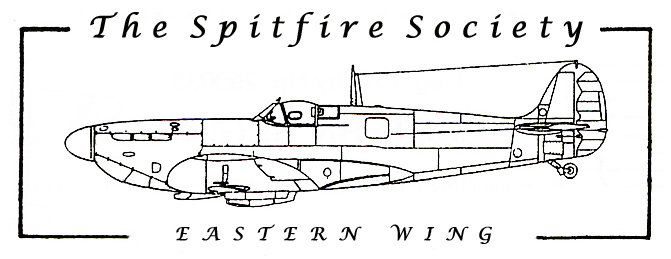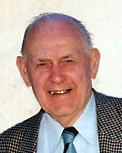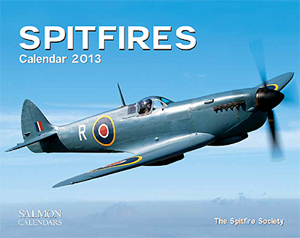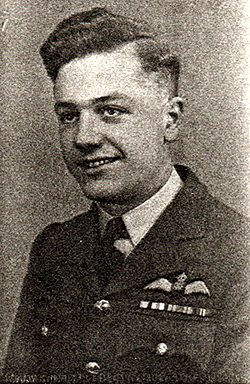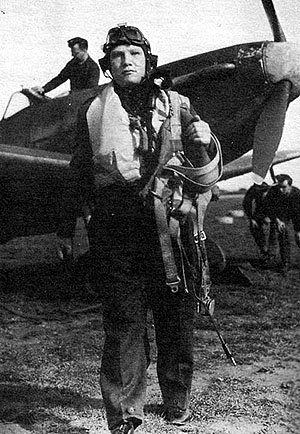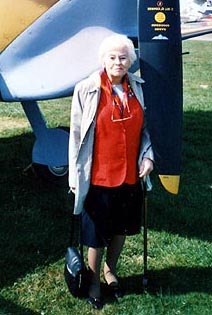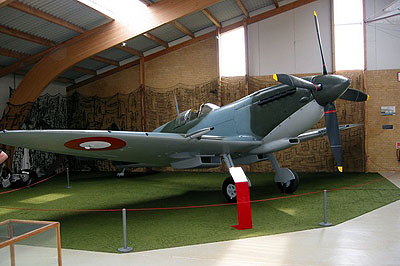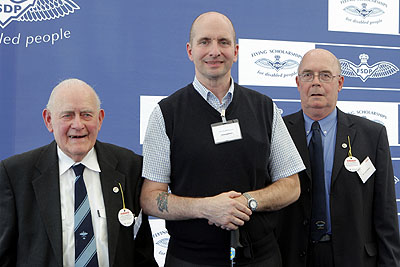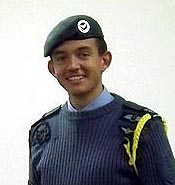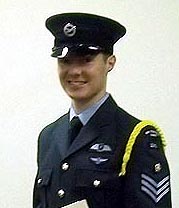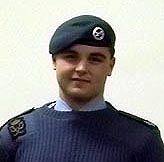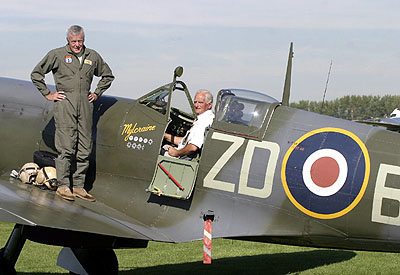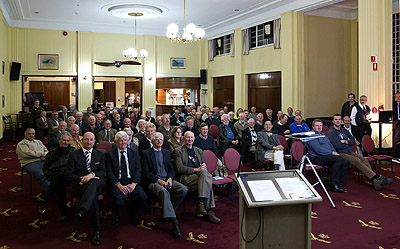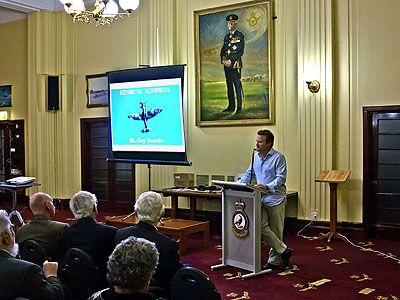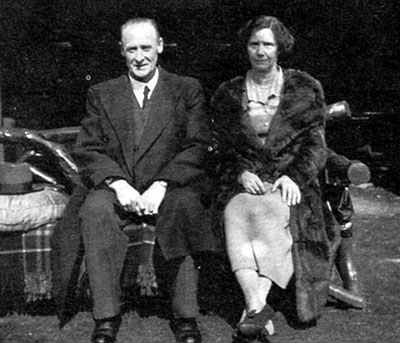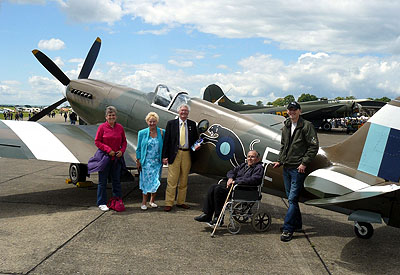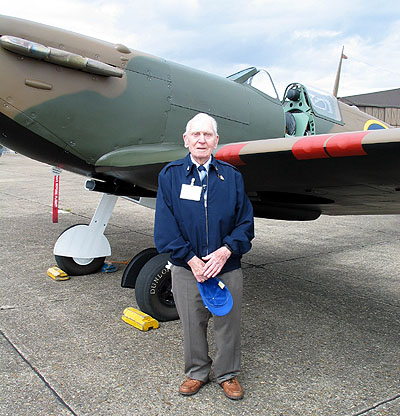 Home Page
Pat Butler
|
INDEX
From the Chair
General Announcements
A Day in the Life of a Fighter Pilot in WW2
A Ferry Story Part IV
Flying Scholarships for the Disabled
The Butler / Stillwell Memorial Award
Commemoration of The Battle of Britain
---------- With the last
air show at Duxford now done and dusted we can reflect a little
on the year. The dedication
and commitment of our committee and helpers has been as great as
ever, perhaps even a little greater and I thank them very much
for that. Also many thanks to Peter and Gerard for editing our
Newsletter, well done! Although
conditions have been difficult it has been a successful year.
The future looks very good. My New Year’s
wish is that the tranquillity prevailing in the Eastern Wing
would extend to other areas of our society. May I now wish
you all a Merry Christmas and a very healthy and Happy New Year. From wherever
you have come, or are going to, “Keep the faith”. David
----------------------------------- Welcome to Form 700 Welcome to issue
number 58 of the Form 700. First of all, many congratulations to
Gerard Crutchley who was the recipient of this year’s Founders’
Trophy, awarded in memory of David Green, the initiator of the
Spitfire Society, and given to the person deemed to have done
the most for the society in the previous year. For undertaking
vast amounts of work in a variety of spheres Gerard was deemed
to be the most suitable candidate this year and quite rightly
so; on behalf of the Eastern Wing committee and membership, well
done Gerry, and thank you!
Sadly in this
issue we report the passing of two more close friends of the
Eastern Wing, Audrey Morgan and Albert George Morgan (no
relation) who both died earlier this year; tributes may be found
elsewhere in this magazine. We would also wish to take this
opportunity to pass on our deepest condolences to the family and
friends of Andrew Stillwell-Cox who died under such sad
circumstances on the 21st of July; our kindest thoughts are with
them. In this issue of
the Form 700 we are very pleased and privileged to present items
written by the late Squadron Leader Leonard Feltham DFC; Sqn Ldr
Feltham led a varied and frequently hazardous wartime career,
serving with 232 and 127 Squadrons, and survived being shot down
and badly wounded in the remote Western Desert. His DFC citation
stated that he showed “initiative, courage, and determination of
a very high order” that he had always displayed in the face of
the enemy. Leonard Feltham died in 2009, and the items
reproduced in this magazine, written during the war as a Flight
Lieutenant, were sent to us by the late Squadron Leader’s wife,
Mrs Patricia Feltham, to whom we extend our sincerest gratitude. Other items
include the continuing story by Geoff Bates of his service life
as an ATA pilot, and the variety of people and experiences that
he encountered. There is also a report on the Pat Butler and Len
Stillwell awards, and some splendid items by our very own Vice
Chairman Mr Steve Williams; we hope you enjoy them. In other news, a
wreath was laid at St. Andrews Church, North Weald on behalf of
The Spitfire Society by Squadron Leader Ian Blair DFM to
commemorate Battle of Britain Day; thank you Ian. A wreath will
also be laid at the North Weald Airfield Memorial on Remembrance
Day in November. Special mention once more to Wing member Eric
Horwood for organising the wreaths and his on-going commitment
and steadfast support at these and other events over the years;
thank you Eric.
Calendar Time!
The Spitfire
Society calendars for 2013 are now on sale and follow the same
successful format as previously; twelve beautiful colour
photographs, with the calendar area presented underneath. Once
again the pictures come to us courtesy of Darren Harbar
(website:
www.focalplaneimages.co.uk) and James Wheeler
(website:
www.jameswheelerphotography.com) two very
gifted photographers to whom we extend our thanks. Anyone who
has seen our previous calendars will know how good they are, and
if you haven’t I can tell you they are most excellent! Calendars are
priced at £6.10 including postage and may be obtained from Wing
Committee member and all-round decent fellow Jason Amiss, whose
contact details may be found on the back page of this magazine. Merchandise Appeal On the subject
of Spitfire Merchandise, we are encountering a lot of problems
in getting items to sell on the Eastern Wing sales stand at
Duxford and this is having a severe impact on the funds we have
been able to generate for the Spitfire Society this year. If you
have any books, magazines, videos, DVD’s or artefacts that you
feel you would like to donate, they would be very gratefully
received. A Very Special Birth-date On November 7th
1912 aviation legend Alex Henshaw was born and so this year he
would have been one hundred years old. Alex, who died in 2007,
was already a household name before the war in the exciting and
popular field of air-racing, gaining numerous victories
including winning the 1938 King’s Cup and breaking the
London-to-Cape Town endurance record, both flying the diminutive
but deceptively lively Percival Mew Gull. During the war
the great Jeffrey Quill appointed Alex as Chief Test Pilot at
the mighty Castle Bromwich plant near Birmingham where
Lancasters and Spitfires were assembled; it is estimated that
Alex himself tested around ten per cent of all Spitfires built.
His evocative
books Sigh for a Merlin, Wings Across the Great Divide and
Flight of the Mew Gull - which puts the reader firmly in the
cockpit with him on his astonishing flight to and from Cape Town
- are aviation classics. A great aviator
and an inspiration to many, Alex was a Patron of the Spitfire
Society and a particular friend to this region, so it was of
course only right that we make note of this special day and
remember with fondness a great man.
PW ----------------------------------- A Day in the Life of a Fighter Pilot in
WW2 By Flt/Lt L W Feltham Midsummer meant
a long day for the fighter pilot, with dawn at four o'clock and
dusk not until as late as nine or ten at night. At three thirty
I'm awakened with a cup of sweet tea. The half dozen of us in
the tent don't talk. Just sluice the face with cold water, dress
in battle dress, flying boots, Mae West, an inflatable life
jacket in case you come down in the sea, and off to dispersal
where the Spitfires are waiting, re-armed and re-fuelled and
warmed-up by the dedicated ground crew. We wait for the
briefing - that is, the target or whatever duty we have been
assigned on this dawn sortie. It might be as high escort to
bomber squadrons attacking armament factories, a sweep at twenty
thousand feet to try to lure the enemy's fighters up for a
scrap; or we may have a target to attack ourselves with the 500
pound bomb slung under the fuselage and a 250 pound bomb under
each wing. It's a
dive-bombing trip to eliminate an enemy stronghold which is
holding up the advance of our own infantry. Take off is at five
fifteen. We climb aboard
the aircraft, strap ourselves in, pull on helmet, oxygen mask,
gloves, test the control surfaces - the ailerons and rudder, and
wait. My mouth is dry and I can feel my heart pounding. Then
from the control tower a green Verey light is fired and we start
up. We taxi out and take off in pairs and quickly form up into
three sections of four in line astern. Once the action has
started the apprehension disappears. We climb to ten
thousand feet and, as we near the target, only about twenty
minutes flying time away, the commanding officer gives the order
'echelon starboard'. We're now in an attacking formation. We see
the target, pass over it. All is quiet. Then the leader peels
off in a dive and the remaining eleven pilots follow him, gun
button switched to on, bombs primed, gun sight, which we'll use
to aim our bombs, switched on. By now the anti
aircraft fire has opened up. You can see the balls of tracer
bullets floating up gently towards you and when they reach you
they flash by at great speed. They look quite pretty, like
Christmas tree lights and not dangerous at all. There's no
turning back now. Regardless of the flak, you're on your bombing
run and that commands your whole attention. We will dive in a
near-vertical dive from ten thousand to six thousand feet, gun
sight on the target, pull through the target and release the
bombs then pull back on the control column at full power to get
out of the flak. Then we go in to rake the stronghold with
cannon and machine gun fire. We turn for home. There's been no
action from enemy fighters this time. But there probably will be
next. We form up in squadron formation; we're one missing. Approaching base
we peel off for landing, taxi in and switch off. The ground crew
are eager for news of the sortie. So is the intelligence officer
whose task is to assess the effectiveness of the operation. We
pilots gather in the mess tent, subdued because a fighter
squadron is a very close-knit unit and the comradeship between
us and affection is very great. Losing a fellow pilot is all too
common. But, life has to
go on. We're ready for breakfast. It's just after 6.45. There
will probably be four or five more sorties today if the
weather's good. But by about seven in the evening we are 'stood
down'. No more ops for today. So we're off to the mess for a
hilarious evening, when we drink more beer than we should. And about
eleven, the telephone rings. The mess falls silent. Someone
answers; puts the phone down. "Briefing four thirty tomorrow". I Have Been Alone Flt/Lt L W Feltham 1944 Aged 23
When sullen clouds prolonged the night
And held impatient day's onset,
The Spitfire stood, a silent silhouette
Against the distant hills, its dappled wings all bright
And glistening in the rain.
Sweet, sleek aeroplane …
Yet with a viper's sting concealed amid her grace.
Then I, with parachute and flying boots encumbered
Climbed awkwardly aboard. Yet slumbered
The world, indulged in dreams of peace,
Till I exultantly
And triumphantly
Caused the engine's sweet snarling roar To
burst upon their eardrums. Rude
Awakening to a war-filled day. The Spitfire stood
Shiv'ring in impatient ecstasy, eager to soar
Above the earth
And show her worth.
Slowly she rolled, then gathered speed and rose
Into her element the air, and left behind the land
While I caressed her with a lover's hand.
Contented now her voice, but eager set her nose
Towards the cloud.
Swift and proud
Into a strange and solitary place flew
She and I. How soft the mist that round her furled
Swirled and eddied in a lonely world.
How distant seemed that other world below.
And other men
And then …… and then!
Gradually pale light began to stray
Into that darkened eeriness. Dawn
Began to break and, suddenly forlorn,
The clinging clouds dropped away
Far, far below In
splendid show.
White-gleaming in the sunlight's glare
And stretched unceasing to the end of Time. A
wondrous sense of happiness achieved climbed
Aboard my heart. For only she and I were there In
harmony.
Yet an ecstasy I
felt, a Presence close at hand, deafened My
heart with song; unspoken words did say
That I was not alone. I think that on that day I
touched the fringe of Heaven. ----------------------------------- Part IV Geoff Bates If you have not read Part I, II & III, you can find
them here:
The Landlady
and Cross Green Bowling
... Whilst at the
Holding Centre at Morecambe we were billeted in private housing.
Four of us were allocated to one house, a tall tenement house
with a cellar, three floors and two small attic bedrooms which
were allocated to us. Our party comprised two officers and two
warrant officers. As soon as we
arrived the landlady lined us up in the hallway. “I don’t care
how many Jerries you’ve shot down, you’ll do as I say when you
are in my house,” she informed us in a way which would have made
a drill sergeant proud. She then proceeded to tell us the rules
of the house. One was that we were not to have any women in the
house at any time, “not even your mothers.” The times for meals
were stipulated. If you weren’t punctual you didn’t get a meal –
it was as simple as that. The front door would be locked at
10.45pm; if you were late you would have to find somewhere to
spend the night. Nobody was to come downstairs to let in a
latecomer. No smoking at any time. Lights out at 11pm. “I don’t
know how they expect me to feed you lot on what they pay me!”
The list was a mile long. When it was all over you expected her
to say “Squad, attention! Right turn! Dismiss!” One chap apropos
of our having to find someone else to spend the night with if we
were not in by 10.45pm said he thought of asking our landlady if
she knew of any good addresses; I said the subtlety of the
question would have been lost on her. On my demob leave I went
to see the play ‘Worm’s Eye View’ in London. I’m positive it was
based on our landlady! Whilst in
Morecambe we used to play bowls. In that part of the country
they play crown green bowls which is played diagonally across
the green which has a crown or arched surface. We were not at
all popular with the locals who took their bowls very seriously.
First of all we were novices and hadn’t a clue about the bias on
the woods and whether we should use finger or thumb bias.
Secondly, we used to hit the local’s woods or we would pitch our
jack in the middle of the green, which really mucked up things.
I’m sure they were delighted when we were posted after three
weeks. Hoppy Soon after my
return from the holding centre at Morecambe a very forceful
character joined us. In 1938 he was a cadet at the Royal Naval
College, Dartmouth, but lost his right leg in a mid-air
collision the following May. Doctors were
fighting to save his remaining leg when he heard about the
exploits of the legendary Douglas Bader. Hoppy wrote to Bader
whose reply inspired him to return to flying, but it would
necessitate having his badly-damaged left leg removed; this he
readily agreed to. He was fitted
with artificial legs which were not the sophisticated ones of
today; the tin legs were attached to his body with numerous
leather straps which made a squeaking noise as he walked by
throwing one leg after the other. He had been over six feet tall
and was a very broad fellow with red hair. When first fitted
with the legs he kept falling over. The only way he was able to
walk successfully was with the reduction of the length of the
legs, so that his height was reduced to about five foot eight
inches. He made such a good recovery that he re-joined the Royal
Navy, but after attempts at deck-landings, he told The Admiralty
that the rigours of carrier flying presented too many problems,
and he was transferred to the RAF. On the 23rd
November 1943, during a high-level recce with 501 Squadron, his
Spitfire developed engine trouble obliging him to attempt a
forced landing. Blasted by flak, he passed out and crashed some
40 miles from St. Omer where Frenchmen pulled him from the
blazing wreck. Hoppy was
repatriated to the UK in September 1945 and, after plastic
surgery, joined No.12 Ferry Unit where we he was known as Hoppy
to his face. Hoppy left the RAF in June 1946. He was the subject
of a ‘This is Your Life’ programme in 1958 but, alas, I missed
it. I can’t vouch
for this story although I could well believe it, that thanks are
due to Hoppy for the fact that disabled drivers – and I am one –
can park on yellow lines. He also wrote a book called ‘Best Foot
Forward’ which I enjoyed - having known him – when he wrote that
he was a very shy person, particularly as far as women were
concerned! He always liked
to tell the story of Douglas Bader when he was invited to talk
at a famous girls’ school about his experiences as a POW. He
started by recalling how, flying Spitfires, he and other members
of his Squadron were returning from a sortie when three Fokkers
dived out of the sun, pouncing on him and his colleagues. His
aircraft was severely damaged by cannon fire and he was forced
to bail out. He was captured and taken to a POW camp. The
Headmistress interjected to explain that Fokkers were German
fighter aircraft, whereupon, according to Hoppy, Bader replied
“The Fokkers were actually Messerschmitt 109 fighters”. As the
reader can well imagine, I could write screeds more about Hoppy.
He certainly was a character. (see next article for more on
Hoppy) I was posted
home in February 1945, although the war in Europe did not finish
until May 1945 and the Japanese war went on until mid-August
1945. We were now concentrating on getting aircraft out to the
Far East as quickly as possible for after the Germans
surrendered we did not know how long the Japanese would try to
resist the advance of the Allies. Had it not been for the atomic
bombs I feel sure that the Japanese would have fought on longer. The A.B.U.’s had
now become Ferry Units. We used to fly a medley of aircraft
(Tempests, Corsairs, Hellcats, Vengeances and Spitfires) either
to Cairo for No.1 F.U. to ferry to No.2 F.U. in India to fly to
squadrons fighting the Japanese, or we would take them all the
way to Karachi or Nagpur in Central India. There were other
places that we did one-offs, e.g. taking aircraft out to Malta.
Then followed Martinets to Pau not far from the Pyrenees where
they were going to be used to train French pilots. This was
quickly followed by taking Argus III aircraft to Prague where
they too were going to be used for training pilots. No sooner back
than off to Silloth near Carlisle for more Argus aircraft; this
time the destination was Oslo. The Argus doesn’t carry much
fuel, so we had to make frequent stops. First night stop in
Eindhoven in Holland; next night stop Copenhagen. Here the
Tivoli Gardens were being prepared for opening to the public,
and one could have free rides, provided the authorities were not
held responsible for any accidents!
To
be continued… -----------------------------------
This article appeared in
a recent edition of The Spitfire Association newsletter (our
colleagues in Australia) and is reproduced with their kind
permission. The famous Douglas Bader
was not the only legless pilot to engage the enemy from Biggin
Hill and other RAF Airfields. A lesser known pilot, Colin
Hodgkinson, born in Wells, Somerset in 1920, of excellent
pedigree; the son of decorated soldier and airman Gerard William
Hodgkinson. Colin was accepted in 1938 for pilot training as a
midshipman in the Fleet Air Arm. During his training, his
aircraft was involved in a mid-air collision; grievously
injured, Hodgkinson had to have both his legs amputated. During the long period in
hospital, the famous plastic surgeon Sir Archibald Mclndoe
operated on one of his eye sockets and Hodgkinson was
subsequently accepted into the Guinea Pig Club founded by
Mclndoe for burned pilots. Inspired by Douglas Bader, Hodgkinson
was determined to return to flying and to fly the Spitfire. He
managed to obtain a transfer from the Royal Navy to the RAF as a
Pilot Officer. After
training on Spitfires, Hodgkinson was posted on 7 December 1942
to No 131 Squadron at Westhampnett, Sussex. When his squadron
left, he obtained permission to remain in the Tangmere Wing and
joined No 610 Squadron (OC 'Johnnie' Johnson). In April 1943 he
shot down a Fw 190 that crashed into the sea off Brighton Pier.
Hodgkinson was later posted to No 611 Squadron at Biggin Hill,
equipped with Spifire Mk IXs. In August, when flying from
Coltishall, Norfolk, Hodgkinson was escorting American B-26
Marauders bombing Bernay airfield when his squadron came under
attack by more than fifty Fw 190s. The Wing turned for home
and the in the furious dog-fighting that followed, he shot down
a Fw 190 that was about to attack his wing leader, 'Laddie'
Lucas. Hodgkinson then joined No 501 Squadron as a flight
commander but in November 1943, during a high altitude weather
reconnaissance detail, his oxygen supply failed, and he crashed
into a French field. Badly injured and minus one of his metal
legs, he was dragged from his blazing Spitfire by two farm
workers. Captured and placed in a
PoW camp, he was repatriated ten months later. On returning to
Britain he was again treated for his injuries by Mclndoe. He
resumed flying towards the end of the war as a ferry pilot based
at Bristol Filton Aerodrome. He was released from the RAF in
1946 but returned to military flying three years later flying de
Havilland Vampires with Nos 501 and 604 Royal Auxiliary Air
Force squadrons until the early 1950s. Civilian life
presented fresh challenges, and he plunged enthusiastically into
the post war regeneration of advertising and public relations.
From the agency Erwin Wasey he moved into PR, learned the ropes
and broke away to establish Colin Hodgkinson Associates.
With the drive and press-on spirit carried over from fighter
days, Hodgkinson prospered, and attracted a mix of prestigious
and solid industrial accounts. Hodgkinson
also tried politics, standing as a Conservative in the safe
Labour seat of South West Islington in the 1955 general
election. He made an impressive debut and rediscovered his
youthful boxing skills in a punch-up with Labour supporters.
Articulate and a fluent writer, Hodgkinson was briefly
air correspondent with the fledgling ITN. In 1957 he published
Best Foot Forward, an entertaining account of his life until
then. In 1986 he
moved permanently to his holiday home in the Dordogne. He
married first wife June Hunter, a former fashion model. After
her death he married Georgina, a Frenchwoman, who survives him.
Colin 'Hoppy' Hodgkinson died on 13 September, 1996 aged 76. ----------------------------------- Audrey Morgan
In February this
year we lost another dear friend when Audrey Morgan passed away. Audrey had been
a supporter of our region for many years, joining up with her
husband John in the early days of what was then the Eastern
Region. When John died
Audrey carried on with her support as she had become such an
integral part of the activities of Eastern Region. Right up
until the last weeks of her time with us, Audrey was as active
and committed as ever – working hard for hours on end at the air
show sales stand, selling raffle tickets at our Annual General
Meetings, supporting our committee meetings, visits, activities
and countless other things. The amount of money that Audrey’s
hard work must have generated for the Spitfire Society over the
years is beyond calculation, but of greater value must surely
have been the impression she left on the general public as an
ambassador for our society, always giving time to share her
wisdom, knowledge, experience, kindness, compassion, wit and
gentle, wry humour with everyone she met. During the
Second World War, Audrey was a member of the Women’s Auxiliary
Air Force, during which time she had a few close shaves with
enemy action, being right in the thick of things performing
vital work at key fighter stations such as Hornchurch and
Hawkinge. It was as a WAAF that Audrey first became acquainted
with the Spitfire, and with John. It seems hard to
imagine our region without Audrey – the memory of the
cheerfulness that she brought with her, even under very
difficult personal circumstances, and her heart-warming kindness
will be remembered always by those lucky enough to have known
her. PW A fascinating
article that Audrey wrote for the Form 700 in 2008 may be found
in the 'Archives'
section of this website. Albert George Morgan
The early part
of 2012 was a sad time as we lost another of our good friends
when on Friday the 4th of May, Albert – or George as we knew him
– Morgan passed away. George was one
of our most reliable and consistent helpers on the regional
sales stand, attending numerous air shows at Duxford throughout
recent years. Resplendent in his smart blazer, George was always
a big hit with the people who approached the stand – his
memories of life in the wartime RAF, his evident affection for
the Spitfire, a ready sense of humour and a sincere interest in
other people combined to make for a man that was a great
pleasure to work with. As well as
putting in countless hours representing the Spitfire Society at
air shows, George also supported our various other activities
such as social occasions, visits and outings. I remember some
years ago at one of the special Spitfire events at Duxford,
George was helping us look after some of the aeroplanes.
Sheltering from the afternoon heat on a chair strategically
sited under the port wing of a Spitfire, George found himself on
a number of occasions being asked to emerge and pose for
photographs with members of the public in front of the legendary
aircraft, a duty which he readily undertook with his usual good
grace and modesty. George was a
lovely man, one of a kind and a real gentleman; we will miss him
very much.
-----------------------------------
Steve Williams A long
preserved, but seldom mentioned Spitfire is MA298 in the
Danmarks Flymuseum at Stauning in Denmark. This aircraft was
built as a Mk Vc, but converted to a LF IX by Rolls Royce at
Hucknall, which makes it a very interesting survivor. I believe
it to be the only complete example of such a conversion. The first three
dates on the AM Form 78 (Airframe Record Card) are: 27/5/1943
Rolls Royce 03/7/1943 39
MU 14/7/1943 234
Squadron However, 234
Squadron was never operational on Mk IX's so why the allocation?
The answer, I think, lies in a little known episode of World War
II. No. 246 Group
was formed on the 3rd July 1943 as the air component of a force
that was to intervene in Portugal, presumably in the event of a
hostile reaction to the planned Allied take over of that
country's territory in the Azores. The Groups'
units, No's 96, 98, 130 and 234 Squadrons assembled at Honiley
later that month. Sadly no Record Book (Form 540/541) appears to
have been completed by 234 Squadron during this period, no doubt
due to the fact that only the pilots were sent to Honiley, the
ground staff being posted to No.1 P.D.C. (Personnel Despatch
Centre), West Kirby, so that those eligible could be equipped
for overseas service. Fortunately the records of 130 Squadron do
exist so we can get a good idea of what 234 was doing during
this period. Most of July was
taken up by the performance of numerous consumption tests.
Clearly the idea was for the Beaufighters of 96 and the
Spitfires of 130 and 234 to fly across the Bay of Biscay
escorted by the Mitchells of 98. The perceived
danger having passed, the assembled units dispersed and No. 246
Group was disbanded on the 9th August 1943. No. 234 Squadron
reformed without aircraft at West Malling on the 5th August, and
on the 7th collected an outfit of Spitfire Mk V's from 122
Squadron which had re-equipped with Mk IX's. What then
happened to MA298? At present I do not know. A lengthy search
through many documents has, so far, failed to locate it serving
with any unit during the remainder of 1943. The next date on
the record card is the 17th March 1944 when it is shown as being
allocated to RAF Milfield and I assume this was for the Fighter
Leaders School which was based there. It should be noted that
there were five other Rolls Royce Spitfire LF IX's with similar
histories (JL107, MA645, MA646, MA651 and MA657), albeit without
a mention of 234 Squadron. If anyone has
information regarding any of these aircraft during this period I
would be more than pleased to hear from them. The rest is
simply told. In June 1945, its flying career over, it was placed
in store, and, in 1948 was passed to Denmark as an instructional
airframe. Since 1951 it has been either stored or on display at
various locations.
-----------------------------------
Flying Scholarships for Disabled People
Steve Williams As many of you
will know, we have again sponsored a place for a person on the
2012/13 course under this scheme. The charity was set up in 1983
in memory of Group Captain Douglas Bader and selected candidates
are given the opportunity to learn how to fly. This includes 35
hours flying time, relevant ground school and supporting exams. In July David
Williams and I were invited to RIAT at RAF Fairford to meet
‘our’ student, Mr Zan Marseilles, and to be present at the award
of the scholarship certificates. Zan was very seriously injured
in a motorcycle accident but certainly seems to have a
remarkable outlook on life. The certificates
were awarded by the charity's patron, His Royal Highness Prince
Faisal of Jordan, assisted by Air Chief Marshal Sir Stephen
Dalton. We would like to
wish Zan and all the other students the very best for the
future.
http://www.fsfdp.org.uk/index.html ---------------------------------- The Eastern Wing
Annual General Meeting was again held in the Princess Charlotte
Suite at Old Warden this year. The meeting followed on as usual
from the Pat Butler Memorial Awards in which two outstanding
cadets are chosen by the Officers Commanding, London & South
Eastern Region, Central and East Region Air Cadets and presented
with their awards - a cash bursary plus a certificate and
membership of the Spitfire Society. These awards are
presented in memory of Pat Butler, who flew Spitfires from 1942
onwards serving first with 1435 Squadron in Malta followed by
130, 256 and 153 Squadrons in North Africa, Sicily and Italy.
Pat was one of the original members of The Spitfire Society and
the founder of Eastern Region. He died in 1993. The Pat Butler
award was this year joined for the first time by the newly
inaugurated Len Stillwell Award for Most Promising Cadet. Len
flew Spitfires in Italy with 92 Sqn and was wounded in action,
an injury that caused him great pain right up until his death.
Len went on to serve on our regional committee for many years
and along with his wife Dot (herself a former WAAF, working on
bomber airfields in Yorkshire and Lincolnshire) was a dedicated
member of our sales stand team, getting up in the middle of the
night and travelling up to places like Duxford, often travelling
hundreds of miles a year and in the spirit of a true charity
volunteer (and in common with all of our volunteers – HQ please
note) never asking for a penny in compensation. He was a
marvellous man who represented all that we associate with the
true spirit of the Spitfire. When he died in 2008 he left a
generous bequest to the Spitfire Society and it is in his honour
that the award is given. I am sure that like Pat Butler, Len
would have been very pleased with the candidates chosen. The list of
achievements of our awardees is quite extensive and we would not
wish to risk embarrassing them by listing here every single
accomplishment! Once more we had two exceptional cadets for the
Pat Butler Award whose enthusiasm, dedication and diligence has
taken them far with the ATC, and for the Len Stilwell Award a
young man who is already doing great things. Pat Butler Awards
Cadet Warrant
Officer Anthony David Snook joined the corps in 2007 and via
the classification system achieved Instructor Cadet in March
2010 and through the rank system became Cadet Warrant Officer in
April 2012. He has achieved a number of qualifications over the
years and flew solo in a Viking glider for the first time in
July 2010, going on to do the Advanced Glider Training and
completing a course through the Air Cadet Pilot Scheme which led
to solo flying in a Grob Heron single-engine training aircraft.
Anthony starts University shortly, and aims to go on to join the
RAF as a pilot.
Cadet Flight
Sergeant Shaun Joseph Kellam has accomplished much in his
six years with the ATC including representing his wing and the
corps in events such as cross country running, athletics,
swimming and rugby; for his achievements he was awarded the
Sports Cadet of the Year trophy in 2009. The list of Shaun’s
successes is extensive; highlights include flying solo in a
glider and gaining his silver wings in June 2010, Bronze Duke of
Edinburgh Award, a pass with distinction with BTEC in Aviation
Studies and Public Services, a pass with merit on the ATC
Leadership Course and following on from the Air Cadet Pilot
scheme, flying solo in the Grob Heron in 2011. Shaun also flew
in a Hawk T1 from RAF Valley in 2010, fuelling his desire to
become a pilot, which he aims to achieve by applying for a RAFA
Scholarship. Longer term, Shaun aims to perform overseas medical
aid and to study medicine at University. Len Stillwell Award
Cadet
Sergeant Harley James Crisp’s family has a history within
the RAF, and Cadet Sergeant Crisp followed in their footsteps by
joining the ATC in 2009. He immediately and enthusiastically
immersed himself in as many activities as possible achieving
numerous awards and medals in areas such as athletics and rugby.
Harley has been involved with the ATC string workshop, working
with the prestigious RAF Salon Orchestra and was awarded a
silver lyre by Lady Dalton, the wife of Air Chief Marshal Sir
Stephen Dalton. Harley takes an abundance of pleasure and pride
in being a part of the Air Training Corps and has a clear
strategy in place to fulfil his ambition of becoming a pilot in
the Royal Air Force. These three
cadets clearly show outstanding qualities and must certainly be
an inspiration to their peers; it is certain that Pat Butler and
Len Stillwell would be very pleased to know that the awards
given in their names were presented to such exceptional young
men. We would like to offer our congratulations on receiving the
Butler / Stillwell Awards to Anthony, Shaun, and Harley and wish
them continued success and all the very best for the future in
the paths that they have chosen to follow.
PW ---------------------------------- As we were all waiting for
final confirmation of the 'Burma Spitfires' discovery, we were
contacted by member Dick Smith who had the following to say: 'Dear Sirs, I don't know
if this is of interest. I was serving at Mingaladon, Burma about
the time the Spitfires were buried. I saw no Spitfires, but did
take part in a similar operation with Japanese equipment.' 'I was at Mingaladon for
about the last 9 months before Burma independence day, leaving
on the eve. As an airframe fitter I worked at base workshops
which was a few miles out in the jungle from the airfield. We
took large bombs on lorries to Rangoon docks and rolled them off
on to a mattress to be shipped out to sea. A large hole was made
a distance away and in it we put hundreds of really good tools.
Sometime later we removed the door from a Dakota, lashed rope
across and flew out to sea when no ships were sighted and dumped
priceless Japanese telescopic rifles.' Dick goes on to tell us
about his encounters with our dear friend, the late Alex Henshaw: 'Before the war I saw
him walking down our village high street with a fruit grower who
I knew. Sixty or so years later I was at Duxford when he laid
the corner stone of the new hangar. I reminded him of this; it
was when he was working for his father selling artificial manure
and he recalled the time and the growers in the village.' He has also sent us a
lovely picture of himself in MH434. Thank you for getting in
touch Dick:
Keith Gaff has sent us
these 2 photos of the Merz Lecture in Australia. It is held in
the Officer Mess Ante Room at RAAF Base Laverton which is a
magnificent art deco building dating from 1941. The speaker this
year was Guy Bourke:
Keith has also very kindly
sent us a photo of RJ Mitchell and his wife Florence - an
important addition to our archives - thank you Keith:
Rob Rooker at
www.152hyderabad.co.uk
joined us at Duxford earlier in the year and has sent us this
picture of himself with F/Sgt Cyril Potter and Bill Smith,
author of 'Birth of the Black Panthers':
And to finish, our friend Sqn Ldr Ian Blair pictured alongside
the Mk I P9374 at Duxford during Spitfire Day:
----------------------------------
This address originally appeared in an earlier Form 700. I would like all our visitors to read it and I am
in the process of finding a permanent 'home' for it on our site.
Commemoration of the Battle of Britain
2008 address by the Rev'd Frances Drake
It is a great privilege to be here today - and I thank you for
the Invitation - to share in this Service of Commemoration and
Remembrance - of the Battle of Britain. As the words in the 'Act
of Remembrance' remind us that:
'We are remembering before God ....... those who fought and died
in Service - in the Battle of Britain -
treasuring memories - and pledging to keep alive the memory of
all those who died in the Royal Air Force - and in the Air
Forces of the Commonwealth.'
My own knowledge of the war is very limited - although not
entirely non-existent. I am a war baby - but along with many
others of my generation over the years - I have listened with
interest
and admiration - to accounts of various war time experiences -
including the Battle of Britain.
Living relatively locally to here - at Navestock - with a Father
who was in charge of a 'Home Guard Unit' at Stapleford Abbots -
and living in a family - where my sister Joan - my parents first
child, was killed in 1940 - during the Battle of Britain - and as
the direct result of a jettisoned German Bomb - I have
experienced and heard a great deal about war time events - and
what people lived through - both in the Forces - and in civilian
life.
I almost 'cut my teeth' on what have become immortal words from
Winston Churchill. 'Never in the field of human conflict - was
so much owed - by so many - to so few'
My parents would often speak of Churchill's speech to the House
of Commons in the June of 1940: 'You ask', he said - 'What is
our aim? I can answer with one word - Victory' - and he went
on to say. 'Victory at all costs. Victory in spite of all the
terror. Victory, however long and hard the road may be. We shall
not flag nor fail. We shall defend our island to the end - with
confidence - strength and courage'.
So today - we remember those who led and inspired - as well as
those who fought. And we remember those civilians - who kept on
going - in spite of the pain - the terror - the deprivations -
and death itself.
Each of those who fought - and who are remembered at this time -
has won a glorious grave - not that grave of earth wherein they
lie - but the living grave of everlasting remembrance - wherein
their glory is enshrined. A Remembrance that will live on the
lips - that will blossom in the deeds - of their countrymen -
the world over.
For the whole world is the tomb of heroes. Monuments may rise
and tablets be set up to them in their own land - but on far-off
shores there is an abiding memorial - that no pen or chisel has
traced; because it is graven - not on stone or brass - but on
the living heart of humanity. Let us take these men as our
example.
Let us like them - remember that prosperity can only be for the
free; that in the words of Pericles of the 5th Century - 'freedom
is the sure possession of those alone - who have courage to
defend it'.
We are to take these men for our example. There is always a
danger however - that things - events - memorials - even our own
Christian faith - can become purely nostalgic - a memory of past
things - sometimes becoming distorted and false in our memory
-something that older people do - and young people tolerate -
but the true meaning and value is lost in time.
History can become an empty husk - fragile - and eventually
meaningless. But our celebration today is far from an empty husk - and if we
seek to understand it properly - it transcends a particular time
in history - or even the RAF - or our nationality - because it
is about the men and women who made the history. It is about their
values - their courage - their sacrifice - and their characters.
This is what is valuable. This is what should be our treasure -
not merely as nostalgia - but as an example of
something real and substantial.
For they have lived the values - that should still be relevant today - and everyday after
today.
The values we celebrate in a Service such as this - do not
change.
They are values for every generation and nationality - that
those who wish to live their lives to the full -
will recognize and acknowledge - and take for an example.
This is not nostalgia - but is rather - real and abiding - and
something worthwhile to pass on from one
generation to the next.
The facts of the Battle of Britain are simple.
In 1940 - out numbered, and fighting for their lives - a few
stood up to the many - and said - 'You will not pass. You will
not overcome. You will not break our spirit'.
What we celebrate - what we admire - is the courage and
character of those young men - that gave them the strength - to put
themselves between the enemy and their homes and families - and
achieve the apparently impossible.
And what are these values?
They are sacrifice and service. Values that are also central to
the Christian faith; for Jesus came into the
Some years ago - I was called out to attend to an elderly man who
was dying. It turned out he had fought in the Battle of Britain.
He had been ill for some time, and over the course of three
years - both his legs had been amputated - not in one operation
- but during a number of these.
As I knelt beside him - ready to give him the last rites - just
as he wanted - he could see that I was upset. He took my hand
and said - 'Don't worry Vicar - I've been going to heaven in instalments'.
Sacrifice and service runs through a person's life - just like a thread
through cloth. For that wonderful elderly man - it was there as
he fought in the Battle of Britain. Sacrifice and Service was
there - as he and his wife worked to make a home for their
children. It was there when he nursed his wife through a long
and painful illness. It was there when he arranged her funeral.
And - it was there - as he himself died whilst offering comfort
to a young priest.
So these are the values that we celebrate today.
Courage; Service before self; Integrity and Bravery.
It is all these things - and so many more - but the most
important is Self Sacrifice.
Sadly - they do not appear to be valued very much by the world.
But to me they are everything.
They are the difference between a life well lived - even if it
was cut short - and a selfish life.
They are the gifts of God - what I would call grace - or the
gifts of the Spirit.
They are the values that help us walk beyond our natural desire
for self-preservation - to meet instead - the
needs of the common good - of others.
What we can all agree on is - that they are at the pinnacle of
what it means to be a human being - for they
are the values that we see lived out perfectly in the life of
Our Lord Jesus Christ.
And as we think about them - we see in their reflection - that
the values so dearly loved by this world - are only shadows -
they are like sand that passes through the fingers and is gone
- but that the values we celebrate today - are solid and hard
won. They are often scorned by those who are weak and self
serving - but equally eagerly embraced by those who see beyond
themselves - those who have the courage to sacrifice their lives
for others - who they do not even know. Those men and women are
those - who recognize what is truly good - and who have the
courage to defend it against all odds.
So let us continue to tell the story of the Battle of Britain to
our children and grandchildren. Let us tell them - how the
Luftwaffe had to destroy the Royal Air Force - before it could
invade. Tell them - how at the beginning of the battle - 2,790
German aircraft were sent against 650 aircraft of the RAF - who
struggled day after day to survive. And then - when your
children ask you how they managed and won - tell them that the
adversity had exposed their true character - and it was solid -
and gave them the courage to lay down their lives - not because
they wanted to - but because they recognized that there are some
things - which are more important even than life itself.
'Never in the field of human conflict - was so much owed - by
so many - to so few'
Amen
--------------------------------------- Form 700
is produced by Peter Wesson and Gerard Crutchley. The previous edition of Form 700 (Winter
2011/2012) can be found here: |
||

